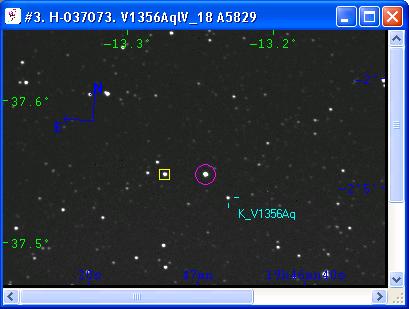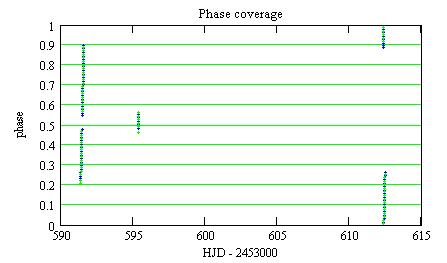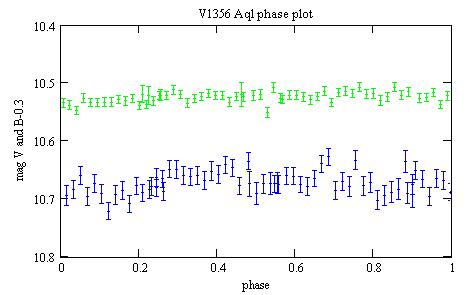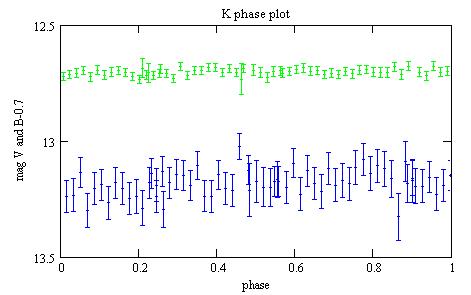V1356 Aql mystery
Observed: 8, 12, 29 Aug 2005
Michel Bonnardeau
14 Sept 2005
Updated: 16, 29 Sept 2005
Abstract
I observe flat light curves for this RR Lyrae star.
Introduction
In the GCVS V1356 Aql is listed as a RR Lyrae (a pulsating star), with the
ephemeris:
period=0.324d
time of maximum: 2,443,698.607 (9 July 1978)
The amplitude of the pulsation: 0.2mag.
Observations
The observations were carried out with a 203mm f/6.3 SC telescope, B and
V filters used alternatively in a filter wheel and a SBIG ST7E camera
(KAF401E CCD). 60 images were obtained with the V filter, 64 with the
B. Each exposure is 200s long. Example of an image:

Image made with a V filter. The yellow square is for the comparison star,
the blue ticks are for the check star, V1356 Aql has the purple circle.
V1356 was observed over 3 sessions that span a complete period, the phase
(between 0 and 1) being computed from the GCVS ephemeris:

Green: V filter observations, Blue: B filter observations.
The comparison star is Tycho-2 5150-00974 with the Johnson magnitudes B=12.248 and V=11.552, computed from the Tycho B and V magnitudes using Mamajek et al (2002). The uncertainties on the Tycho-2 magnitudes are +/-0.243 for Bt, +/-0.183 for Vt. The check star is GSC 5150-00022 with the measured magnitudes B=13.882 (standard deviation 0.072) and V=12.703 (0.014).
The resulting light curves, for V1356 and the check star (K), are the following:

Green: V magnitudes, Blue: B magnitudes minus 0.3. The error bars are +/- the
1-sigma statistical uncertainties.

Green: V magnitudes, Blue: B magnitudes minus 0.7.
V1356 Aql appears to be constant, with V=10.525 (standard deviation 0.009) and B=10.972 (0.019).
Discussion
The references of the GCVS to V1356 Aql are numbered 00470 and 01187:
V1356 Aql was observed by the ASAS and SkyDOT/ROTSE-I/NSVS surveys:
V1356 Aql was discussed on the AAVSO-discussion group on 14-16 Sep 2005, and J.F. Le Borgne explained that the GEOS observations were only an internal publication that should not have been released.
I conclude that V1356 Aql is definitively not a RR Lyrae, and is almost certainly a constant star.
Acknowledgements
I thank the AAVSO for their discussion group and all those who intervened there. The discussion transcript is the thread "V1356 Aql mystery" .
References
Hoffmeister C. (1935) Astronomische Nachrichten 255 401.
Mamajek E., Meyer M., Liebert J. (2002) AJ 124 1670 (appendix C).
Technical notes
Telescope and camera configuration.
Computer and software configuration.
|
|
|||
|
|||
|
|
|||
|
|
|||
|
|
|||
